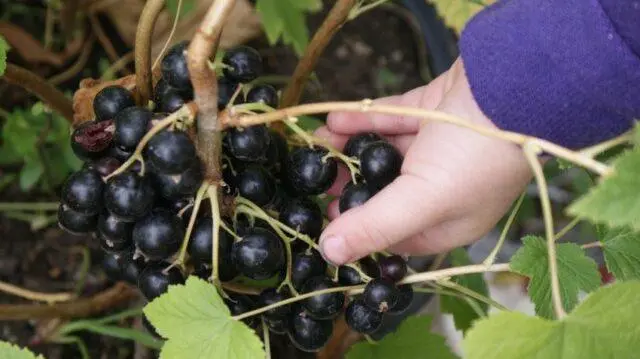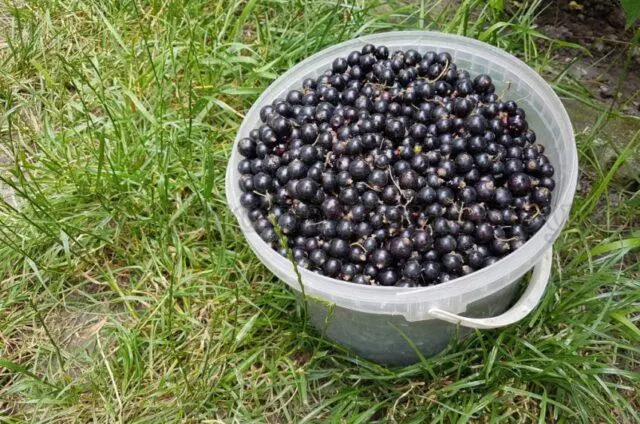Contents
Currant variety Arcadia is a late-ripening crop of selection. Differs in very large berries and high productivity. The purpose is universal: suitable for fresh consumption and for home preservation. You can grow both for yourself and for commercial purposes.
History of breeding
Arcadia is a blackcurrant variety of selection, bred on the basis of the FANTS of the North-East named after I.I. N.V. Rudnitsky. The authors are a team of specialists: T. P. Ogoltsova, A. A. Rusinov, G. A. Plenkina and G. N. Kosolapova. The variety has been tested since 2007 and included in the register of breeding achievements in 2010. Approved for cultivation in the regions of the Volga-Vyatka region:
- Nizhny Novgorod;
- Kirovskaya;
- Chuvashia;
- Mari El;
- Mordovia.
Description of the blackcurrant variety Arcadia
Currant Arcadia gives a medium-sized and moderately sprawling bush with straight shoots of medium and large thickness. Their surface is matte, the color is steel-gray, there is no pubescence.
Currant leaves of the Arcadia variety are three- and five-lobed, medium and large in size. The color is yellow, sometimes with shades. The surface is matte, without pubescence, to the touch with wrinkles. The plate is concave, has deep cuts. The tip is sharp, the blades diverge at a right angle. At the base of the sheet is a recess of medium size. The teeth are small, bent, with a sharp edge.
The flowers of the currant of this variety are pale green in color, with medium sepals. Brushes are both long and short. Their axes are straight, medium in size. The fruits are rare.
The berries of the currant Arcadia are black or brownish-black in color. The size is very large, on average 2,7 g in weight, individual specimens reach 5,2 g. The shape is round, the skin is thin, the number of seeds is small. Peduncle of medium size. The detachment is dry, which makes it easier to harvest.
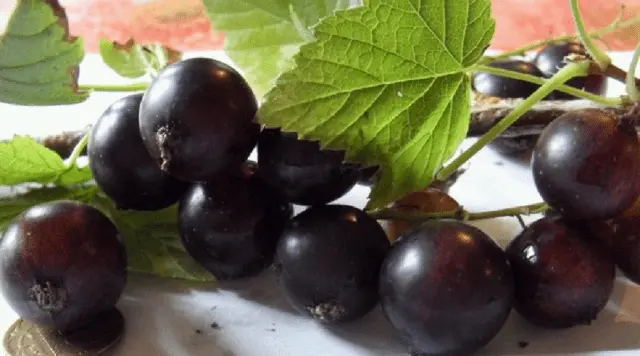
Currant berries of Arcadia are very large
Features
A fairly hardy variety that can withstand both frost and drought. Arcadia has sufficient resistance to common pests. Therefore, it can be recommended for cultivation in all regions of the middle lane.
Drought resistance, winter hardiness
The currant variety is characterized by good winter hardiness – it can withstand frosts down to -25 degrees. But in the Urals, Siberia and the Far East, shoots can freeze slightly. Therefore, culture needs mandatory shelter for the winter.
Bushes adapt well even to prolonged drought. In order to prevent a drop in yield, during a hot and dry period, it is necessary to give additional watering at least once a week.
Pollination, flowering period and ripening period
Currant Arcadia belongs to the self-fertile varieties. Almost all fruits are tied on their own, without the involvement of pollinators. Therefore, it is not necessary to plant other varieties on the site. The culture is late-ripening: flowering begins in July, and the first berries are removed in early August. If the summer is cold, there is a risk of reduced yield and poor taste.
Productivity and fruiting, keeping quality of berries
The variety has a fairly high and stable yield – 2,5 kg per bush (for industrial cultivation – 8,3 t / ha). Fruiting later. The skin of the berries is thin, but strong enough. Therefore, the keeping quality is good: the crop can be stored in the refrigerator for up to 10 days. The fruits can be transported over long distances. Therefore, the variety is suitable for commercial cultivation.
Palatability
The pulp of currant berries of the Arcadia variety is juicy, the taste is refreshing, with a noticeable sourness. According to the tasting assessment, it received 3,5 points out of 5. The composition contains the following components:
- sugar (total) – 8,4%;
- acids – 2,4%;
- pectins – 1,1%;
- vitamin C – more than 85 mg per 100 g.
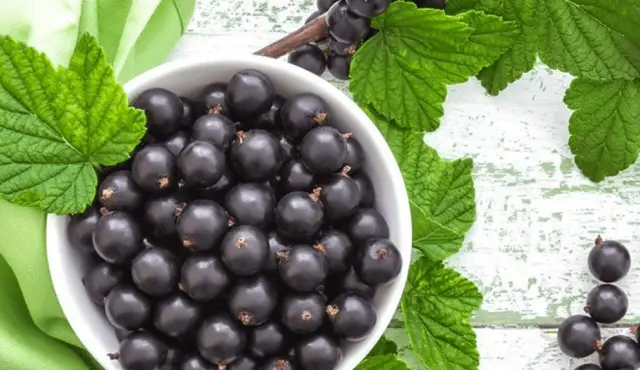
Currant berries of the Arcadia variety have a pleasant refreshing taste.
Disease and pest resistance
The culture has good resistance to bud mites, which distinguishes it from many others. It also has resistance to powdery mildew. But it is possible to be affected by other diseases and pests, for example, rust, anthracnose, aphids, moths and others.
Therefore, in the spring in April, preventive treatment with drugs is carried out annually:
- Bordeaux liquid;
- “RAW”;
- “Score”;
- “Fitosporin”;
- “Tattu” and others.
During the period of active growth (spring and summer), it is necessary to periodically inspect the Arcadia currant bushes. If pests are found, it is necessary to immediately carry out the treatment with folk remedies – an infusion of wood ash, chili pepper, mustard powder, onion peel, a decoction of potato or tomato tops. For more effective destruction of insects, special preparations are used:
- Carbophos;
- “Inta-Vir”;
- “Ephoria”:
- “Vertimek”;
- “Fitoverm” and others.
From the moment of the last spraying to harvesting, at least 3-5 days must pass (the waiting period is indicated in the instructions).
Advantages and disadvantages
Currant variety Arcadia is valued by summer residents for very large berries that are easy to pick. They have a rather sour but refreshing taste. Great for jams and other preparations; are also used fresh. The berry also has other valuable benefits.
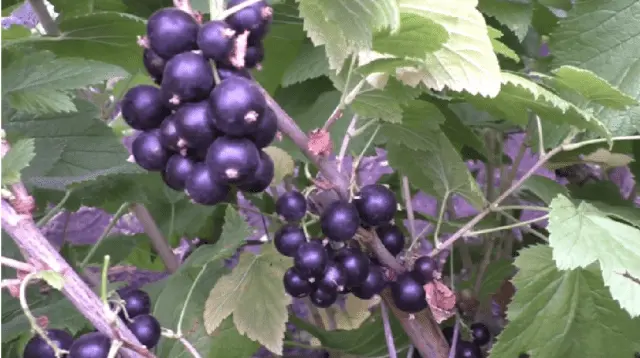
Fruits with a dry separation provide good storage of the crop
Pros:
- very large marketable berries;
- stable and high yield;
- universal purpose;
- high degree of self-fertility;
- resistance to bud mites and powdery mildew;
- transportability and keeping quality.
Cons:
- due to large berries, branches can lean towards the ground;
- late maturation;
- taste with noticeable sourness.
Features of planting and care
For planting Arcadia currant varieties, both spring (April) and autumn (October) are suitable. And the best time is late. The bush will have time to take root and in the spring it will immediately grow. For planting, choose an open, dry and fairly spacious place. Even in the summer, the site is dug up and compost or humus is added – in a bucket of 2 m2. For clay soils, you will need sand or sawdust – 1 kg for the same area.
A month before planting, they dig holes with a depth and diameter of 50 cm at a distance of 1,5 m from each other. Small stones are laid at the bottom, covered with fertile soil with peat and humus from above. When landing, they act like this:
- Seedlings are soaked for several hours in a mixture of water, earth and a growth stimulator solution (Kornevin, Epin, Zircon).
- Placed in the soil so that the root neck goes to a depth of 10 cm.
- Then tamp a little and moisturize abundantly.
- Lay a high layer of mulch.

When planting, the bushes must be watered
To grow a fruitful blackcurrant of Arcadia, as in the description of the variety and in the photo, you can pay attention to the reviews of experienced gardeners who recommend adhering to the following rules:
- Watering of young seedlings is carried out weekly, adults – only during a drought.
- Regular weeding and loosening of the soil is necessary (especially after heavy rainfall).
- Fertilizers begin to be applied from the second season: in April ammonium nitrate (15 g per bush) or urea (20 g), in May chicken manure (1:15) or mullein (1:10), after harvesting – wood ash (200 g ).
- Pruning – every spring and autumn (sanitary, shaping, rejuvenating).
- Mulching with sawdust, needles, leaves – both during the summer and for the winter. In this case, the mulch layer should be high – at least 10 cm.
Conclusion
Currant variety Arcadia is suitable mainly for the Central region. Culture can be cultivated not only in the Volga-Vyatka region, but also in the middle lane, in the North-West and in other territories. Care is not very difficult, so even novice gardeners can get a good harvest.
Reviews with photos about Arcadia blackcurrant
